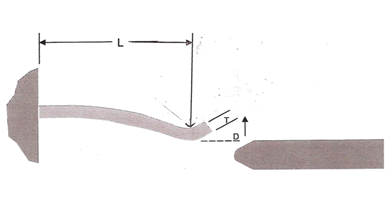Normal Force: A Return to Basics
Thomas Peel of Contech Research shares one of his father’s favorite topics – normal force – and explains in Max Peel’s own words why meeting withdrawal force requirements is only a crude indicator of a connector’s normal force.

Max Peel
As I sit here at my desk, some five months after the passing of my father, Max Peel, I find myself reflecting back to the day I joined Contech Research as a young engineer, just months removed from the nuclear industry. I recall the conversation I had with Max (yes, even I called him Max but never in his house) regarding my future in my chosen profession.
Max asked me, “What do you think about working with your old man?” I thought about it, while looking across the desk at an unshaven man with a striped shirt, torn sweater, and a cigar hanging out of his mouth, and said, “Well, I don’t know anything about what you do.”
His response? “Don’t worry about it, I’ll teach you.” And teach me he did. That was in 1984, and for each day that followed, I learned about the industry and the technology that Max enjoyed so much.
Whether it was plating, contact physics, or testing, my time was spent listening to Max’s unique and in-depth view of the interconnect industry in a way that only Max could express and explain it. Max was my father, my mentor, and my friend, and each day since his passing, I wonder, “What would Max think?”
Which brings us to this article. Several years ago, Max created an electronic library of papers for Contech Research where he could document his views on everything connector-related. His favorite paper was on normal force, and what follows is a brief synopsis of that topic including some excerpts from his “Normal Force – Back to Basics” paper, which he presented at the 20th Annual IICT Symposium back in 1987. So sit back, enjoy a cigar (in honor of my father), and learn from Max, in his own words.
Normal Force: Back to Basics
Most documents specify withdrawal forces (separation forces) as a basic and key attribute to monitor. The common perception is that meeting withdrawal force requirements represents adequate contact normal force and, as a result, establishes the mechanical and electrical stability of the connector system. This, unfortunately, is a myth and at best is only a crude indicator. Very few documents address the issue of normal force.
Basic Relationships
The normal force of a contact system is that force which is generated by the deflection of the receptacle contact spring as it is mated to the plug contact and is perpendicular to these surfaces. Figure 1 shows an example of a cantilever receptacle contact just prior to mating with the plug contact.

Figure 1: Cantilever beam contact system
The contact normal force is the dominant design factor in determining the mechanical and electrical integrity of the connector. The loss of normal force from mechanical and/or environmental stresses may result in an increase in electrical resistance to excessive levels causing circuit faults, intermittence, or false triggering of logic.
Normal force is influenced by or can influence performance characteristics such as:
- Contact resistance
- Wear and durability
- Fretting corrosion susceptibility
- Thermal considerations
- Mechanical forces (total or individual)
- Plating systems used
There are equations which can be used in design to calculate normal force. For the cantilever beam contacts system of figure 1, the appropriate equation is:
F = (D/4) E W (T/L)3
where D is the beam deflection; E is the elastic modulus of the receptacle contact spring material; W, T, and L are the receptacle beam width, thickness, and length respectively.
Such equations should be used for reference purposes only. Caution is advised when using said equations since they have poor correlation between calculations and actual impartial results. These differences are a result of theoretical assumption versus actual factors, which may exist in the application involved such as:
- Equations assume a rectangular cross-section; actual product has a channel effect, which significantly impacts the moment of inertia and the beam’s neutral axis.
- Equation assumes a linear relationship relative to force versus deflection; this is a valid assumption if the contact is operating within the elastic stress range (which is linear). Most contacts (>95%) operate beyond the material yield strength in which the relationship is non-linear.
Having said that, there is value in using these equations. The dimensional interactions are valid from a comparison viewpoint when a “what if” calculation is performed. That is, when an equation indicates a feature has a cubed function, empirical data indicates that indeed it acts as a cubed function. Thus, if the thickness is changed, the percent change can be accurately applied to the empirical data, which has been generated with the original thickness. Thus accurate protection of normal force can be determined but empirical data of the contact must be available.
Based on the indicated uncertainties, normal force characterization is best accomplished by direct measurement in combination with empirical data and field experience. [Tom’s note: Recall that this paper dates back to 1987, before finite element modeling capability had been realized.]
Normal Force Management
While there is no commercially available equipment to perform this type of testing, a system can be created to perform the test. The basic set up should be composed of:
- Holding fixture
- X-Y free-floating table, which may be attached to a motorized feature
- Test probe
- Force transducer interconnected to a linear transducer
- Unit also interconnected to a transducer amplifier and computer/plotter system
The test probe should be as flat and smooth as possible since the contact will move on the surface as it’s being deflected. It also should be a size that does not result in the contact slipping off the probe.
The contact should be tested while assembled to its housing. This is to assure that the spring fulcrum is established and will react as it would in its functional mode. Some designs may not be adaptable to this condition. In this instance, judgment will have to be made in the fixturing concept. Deflection speed has to be consistent, continuous, and at a constant rate.
Figure 2 is a graphic illustration of a force versus deflection plot for a typical contact (in this case, card-edge contacts). This plot shows an initial slope that indicates a preload exists. This preload force generally is created during the assembly of the contact to its housing. The initial step “stakes” the contact in the housing, leaving a free-state dimension in place. The contacts are then deflected and tucked behind features within the housing. The amount of this deflection results in pre-loading the contact. During the mating operation, this force is created within the first 0.001/0.0015-inch deflection of the contact beams. This force becomes additive to the force created by the continuing deflection of the contact beams.
The “basic slope” of the plot establishes the spring rate of the contact which is given by:
Spring Rate = (F1-F2)/(D1-D2)
F1 and F2 are the forces generated at deflection level D1 and D2 from the linear portion of the plot. The spring rate is generally expressed as grams/0.001 deflection.
Projected normal force may be calculated using one of the following equations:
- Normal Force = (Contact Gap/2) x Spring Rate (with no preload)
- Normal Force = Preload Force + (Contact Gap/2) x Spring Rate (with Preload)
The above expressions are valid for the elastic region only.
The “Normal Force” concept is basic, and understanding it must be basic. However, as key as this attribute is, it is rarely specified in procurement documents or controlling specifications. Normal force should be specified. Data indicating that the requirement is being met should be demanded from the suppliers. If the supplier does not want to submit such data, then you must wonder if he is hiding something or if he understands the basic design criteria important to functional product. Demand for connector systems to be more of an engineered product is increasing more than ever before. As with all successful products, their success is based on simplicity and the attention paid to the basic attributes which make them truly perform, not, as so often is the case, on the use of non-basic exotic widgetry. Thus, for connectors, it is back to basics – normal force.
Tom’s Take
My hope is that this paper has provided some baseline information on normal force in addition to a view of Max’s thoughts in 1987 on the topic. There is much more information on normal force that I’ve not included, but may in a follow-up article. Until then remember, “The more you know about your contact, the more you can expect to get out of it.”
Thomas Peel is president and director of test program development at Contech Research Inc.



